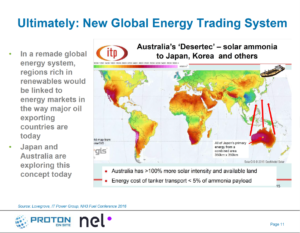Ammonia Energy at the H2@Scale Workshop
By Stephen H. Crolius on June 08, 2017
“Carbon-free ammonia needs to be a significant contributor to the H2@Scale initiative.” This was one of the “key takeaways” offered by Steve Szymanski, Director of Business Development at the hydrogen generator company Proton On-Site, during his presentation at the H2@Scale Workshop that was held on May 23-24 at the University of Houston in the U.S. By the time Szymanski left the podium, ammonia energy had started to move from the extreme periphery of the H2@Scale conceptual map toward its more trafficked precincts.
The H2@Scale website says that it is “a concept that explores the potential for wide-scale hydrogen production and utilization in the United States to enable resiliency of the power generation and transmission sectors, while also aligning diverse multibillion dollar domestic industries, domestic competitiveness, and job creation.” As described in a previous post, the idea for H2@Scale originated with a cross-institutional team drawn from the United States’ National Laboratories. In April 2016, the team presented its thinking at a U.S. Department of Energy “Big Idea Summit.” The concept was embraced and has since been put under the purview of the USDoE’s Fuel Cell Technologies Office.
The agenda for the May 23-24 workshop gave special emphasis to an H2@Scale Roadmap that has apparently been in development since the initiative’s first workshop in November 2016. The (as yet unpublished) document defines R&D focuses in five areas. Ammonia would appear to have relevance in at least four of the five, yet was positioned for the workshop primarily as a fertilizer and one of the major end uses of hydrogen production. In keeping with this framing, Szymanski’s presentation was slotted within a section of the meeting entitled “Hydrogen’s Current Usage in Industry and Transportation”. However, Szymanski had consulted with the workshop’s organizers in advance and received their blessing to expand the scope of his remarks to include ammonia’s potential as an energy carrier. (Full disclosure: the author worked with Szymanski in the preparation of his presentation materials.)

Accordingly, Szymanski started his talk with facts and figures on today’s ammonia industry. Halfway through, though, he pointed to the University of Minnesota’s wind-to-ammonia Zero-Emission Ammonia Pilot Plant as a trailblazer for small-scale, distributed ammonia production that can serve local fertilizer markets. On his next slide, he showed how green ammonia could progress from that starting point to major energy applications such as grid-scale energy storage and fuel-cell-powered vehicles. On a third slide he included a screenshot of a graphic that had been shown at the 2016 NH3 Fuel Conference by Keith Lovegrove, Head of Solar Thermal at IT Power Group in Australia. The graphic depicted ammonia as an energy carrier that can transport renewable energy captured in Australia to end uses in Japan’s hydrogen energy economy. The headline of the slide made reference to the potential for a “new global energy trading system.”
Szymanski went on to make the point that economic modeling has indicated that ammonia is the lowest-cost medium of long-term (multiple-week) energy storage, and then, in keeping with the focus of the workshop, he discussed areas where investments in R&D could make a significant impact. Included on this list was “efficient H2 recovery [from ammonia] through electrochemical and catalytic methods,” and “direct ammonia utilization” via combustion turbines and direct ammonia fuel cells.
Szymanski ended the presentation with his list of takeaways. The three not previously mentioned were:
- “Renewable ammonia production will directly benefit from electrolysis technology and cost improvements in development.
- “Ammonia can play a dual role as both a life sustaining commodity, as well as an efficient energy carrier and fuel.
- “Distributed ammonia production can be located in areas with both high RE [renewable energy] resources and high fertilizer demand.”
Szymanski said his talk was very well received. “People were definitely interested in how ammonia could play a role as a hydrogen carrier,” he said. “Everyone understands the challenges of moving hydrogen. One of the companies in the hydrogen industry said that if the distance is more than 200 miles, it makes no sense to move it as a gas. Liquefaction is a possibility but liquefaction plants are very energy-intensive and expensive. So there is a lot of interest in other ways of moving hydrogen around.”
The next steps outlined for the H2@Scale initiative include completing the Roadmap and prioritizing research efforts.
Szymanski said that in her plenary remarks, Sunita Satyapal, Director of the Fuel Cell Technologies Office, emphasized that the H2@Scale research activity at the National Labs will focus on industry-identified challenges, and will feature close collaboration with industry stakeholders.